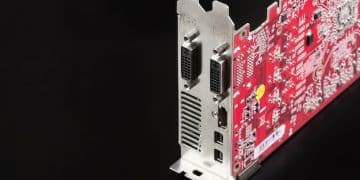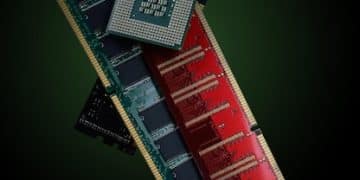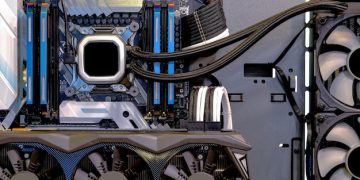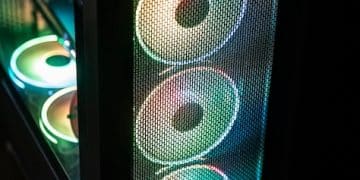Building a Dual-Monitor Gaming PC Setup: Configuration Guide
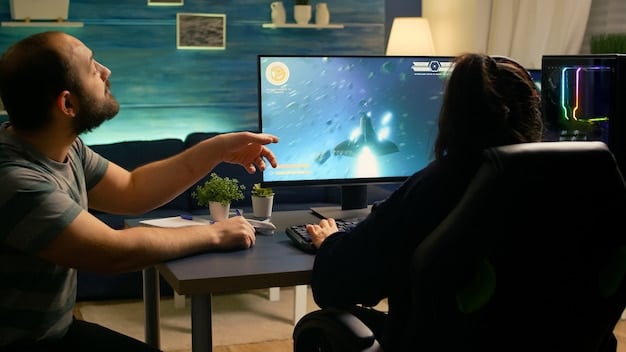
Building a dual-monitor gaming PC setup enhances immersion and productivity by expanding your visual workspace, requiring careful selection of hardware components and software configuration for optimal performance.
Ready to level up your gaming experience? Building a dual-monitor gaming PC setup can dramatically improve both your gameplay and your productivity.
Choosing the Right Hardware for a Dual-Monitor Gaming Setup
Setting up a dual-monitor gaming rig isn’t just about plugging in another screen. It requires careful consideration of your PC’s hardware to ensure smooth performance across both displays. Let’s dive into the essential components you’ll need.
Graphics Card Considerations
Your graphics card is the heart of your gaming setup, especially when dealing with multiple monitors. It needs to be powerful enough to render games on one screen while handling other tasks on the second.
Power Supply Requirements
A more powerful graphics card means increased power consumption. Ensure your power supply unit (PSU) can handle the extra load of running two monitors, along with all your other components.
- Wattage Calculation: Calculate the total wattage required by all your components and choose a PSU with at least 20% headroom.
- 80+ Certification: Look for a PSU with an 80+ certification (Bronze, Silver, Gold, Platinum, or Titanium) for efficiency and reliability.
- Modular Design: A modular PSU can help reduce cable clutter, improving airflow and making cable management easier.
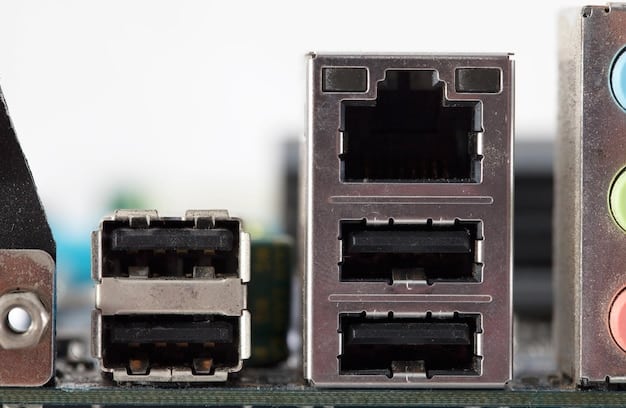
Ultimately, selecting the right hardware is a critical first step in creating a seamless dual-monitor gaming experience. A powerful graphics card and a robust PSU will lay the foundation for smooth gameplay and enhanced productivity.
Connecting Your Monitors: Ports and Cables
Once you’ve chosen your hardware, the next step is connecting your monitors to your PC. Understanding the different ports and cables is crucial for achieving the best possible display quality.
DisplayPort vs. HDMI
DisplayPort and HDMI are the two most common types of display connections. While both can deliver high-quality video and audio, they have some key differences.
Cable Quality Matters
Don’t skimp on cables. Investing in high-quality DisplayPort or HDMI cables can ensure a stable connection and prevent issues like flickering or signal loss.
- Certified Cables: Look for cables that are certified to meet the latest standards (e.g., HDMI 2.1, DisplayPort 1.4).
- Cable Length: Choose the shortest cable length possible to minimize signal degradation.
- Shielding: Cables with good shielding can reduce interference from other electronic devices.
By choosing the right ports, cables, and connection methods, you can ensure that your dual-monitor setup delivers the best possible visual experience.
Configuring Display Settings in Windows
With your monitors connected, it’s time to configure the display settings in Windows. This involves arranging your screens, setting the resolution, and choosing how you want your monitors to behave.
Arranging Your Displays
Windows needs to know the physical arrangement of your monitors so that your mouse cursor moves seamlessly between them. You can do this in the Display settings.
Setting the Resolution and Refresh Rate
Each monitor should be set to its native resolution and maximum refresh rate for optimal image quality and smoothness.
- Native Resolution: Ensure that each monitor is set to its recommended resolution for the sharpest image.
- Refresh Rate: Set the refresh rate to the highest your monitor supports (e.g., 144Hz, 240Hz) for smoother motion.
- Color Calibration: Consider calibrating your monitors for accurate color reproduction, especially if you’re doing color-sensitive work.
Properly configuring your display settings is essential for a comfortable and productive dual-monitor experience. Taking the time to adjust these settings will ensure that your screens work together seamlessly.
Optimizing Your Gaming Experience
Once your dual-monitor setup is configured, it’s time to optimize your gaming experience. This involves tweaking settings in your games and using software to manage your displays.
Game Settings
Some games may require specific settings to work well with multiple monitors. Experiment with different options to find what works best for you.
Software for Managing Multiple Displays
Several software tools can help you manage your dual-monitor setup, providing features like window snapping, taskbar extensions, and profile management.
- DisplayFusion: A popular tool for managing multiple monitors, offering features like taskbar extensions, window snapping, and monitor profiles.
- Ultramon: Another powerful utility for managing dual-monitor setups, with features like monitor mirroring and custom hotkeys.
- Actual Multiple Monitors: A comprehensive tool for managing multiple displays, offering features like window management, taskbar enhancements, and desktop profiles.
Optimizing your gaming experience on a dual-monitor setup involves fine-tuning both in-game settings and using software tools to manage your displays effectively. With the right tweaks, you can create a truly immersive and productive gaming environment.
Boosting Productivity with Dual Monitors
Beyond gaming, dual monitors can significantly boost your productivity. By having two screens, you can multitask more efficiently and keep multiple applications visible at once.
Efficient Multitasking
With two monitors, you can keep your email open on one screen while working on a document on the other, or browse the web while editing photos.
Dedicated Workspaces
Use one monitor for your primary work and the other for reference materials, communication tools, or background tasks.
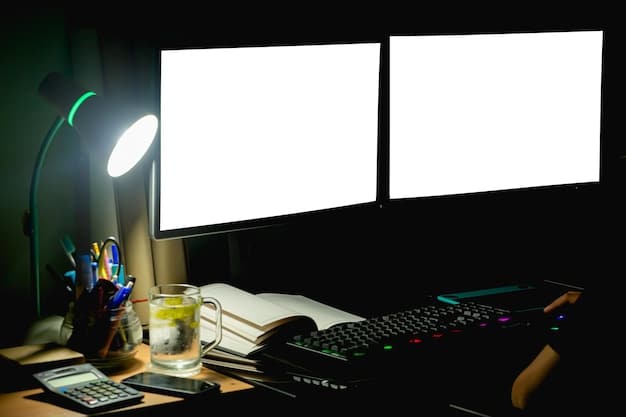
Dual monitors are a powerful tool for boosting productivity, allowing you to multitask more efficiently and create dedicated workspaces for different tasks. Whether you’re a gamer, a creative professional, or simply someone who wants to get more done, dual monitors can make a big difference.
Troubleshooting Common Issues
Setting up a dual-monitor system isn’t always smooth sailing. Here are some common issues you might encounter and how to fix them.
Monitor Not Detected
If your second monitor isn’t detected, try these steps:
- Check Cables: Ensure that both monitors are securely connected to your graphics card.
- Update Drivers: Make sure you have the latest drivers for your graphics card.
- Windows Display Settings: Go to Display settings and click “Detect” to force Windows to recognize the second monitor.
Performance Issues
If you experience performance issues when gaming or running demanding applications, try these tips:
- Close Unnecessary Apps: Close any background applications that are consuming resources.
- Adjust Graphics Settings: Lower the graphics settings in your games to reduce the load on your graphics card.
- Monitor Resolution: Ensure both displays are running at optimal and supported resolution.
By being prepared to troubleshoot common problems, you can ensure that your dual-monitor setup runs smoothly and provides the performance and productivity benefits you expect.
| Key Point | Brief Description |
|---|---|
| 🖥️ Hardware Selection | Choose a powerful GPU and adequate PSU for dual-monitor support. |
| 🔌 Cable Connections | Use DisplayPort or HDMI, ensuring quality cables for stable signals. |
| ⚙️ Software Configuration | Configure Windows settings for display arrangement and resolution. |
| 🎮 Gaming Optimization | Adjust in-game settings and use software to manage dual displays. |
Frequently Asked Questions (FAQ)
▼
You’ll need at least a mid-range graphics card (e.g., NVIDIA RTX 3060 or AMD Radeon RX 6600), 16GB of RAM, and a power supply of at least 650W to handle the extra load.
▼
Yes, you can. However, for the best experience, it’s recommended to use monitors with the same resolution, refresh rate, and panel type to ensure visual consistency.
▼
Ensure your graphics card drivers are up to date, close unnecessary background applications, and adjust your in-game graphics settings to reduce the load on your GPU.
▼
Software like DisplayFusion, UltraMon, and Actual Multiple Monitors can help you manage your dual-monitor setup with features like window snapping and taskbar extensions.
▼
DisplayPort is generally preferred for gaming due to its higher bandwidth and support for technologies like G-Sync and FreeSync, but HDMI 2.1 is also a strong contender.
Conclusion
Setting up a dual-monitor gaming PC can greatly enhance your gaming and productivity experiences. By choosing the right hardware, configuring your display settings, and optimizing your software, you can create a seamless and immersive setup that meets your needs.
